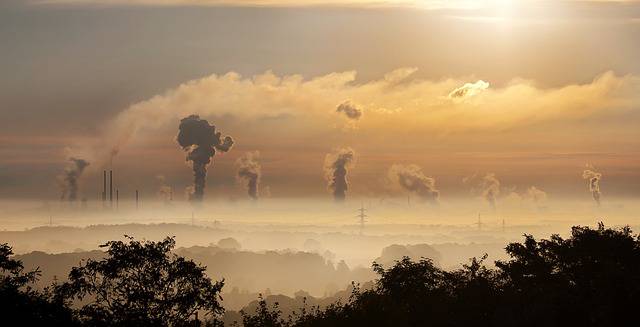Industrial pollution significantly affects our environment. Environmental pollution from industrial activities needs urgent attention. These processes harm nature in many overlooked ways.
Factories and manufacturing are integral to modern life, yet they leave a concerning environmental footprint. Air pollutants from production and chemicals contaminating water and soil contribute to major environmental challenges.
Exploring these issues reveals the true impact of industry on our planet. This blog post sheds light on how industrial activities harm our surroundings.
The post aims to prompt a rethink of sustainable practices for a healthier planet. Understanding these impacts is crucial for developing strategies to protect the environment.
Overview of Industrial Pollution
Industrial pollution refers to the harmful release of contaminants into the environment due to various industrial activities, such as the release of persistent organic pollutants (POPs) like dioxins, pesticides, and industrial chemicals.
These activities, often essential for our daily needs, can unintentionally, impacting human health, emissions of industrial pollutants also adversely affect plants, animals, and their habitats, disrupting breeding cycles and biodiversity.
Major contributors include manufacturing plants, power generation facilities, and chemical industries. The impact is widespread globally, affecting communities and ecosystems.
Factories emitting smoke, power plants releasing gases, and improper waste disposal from industries all contribute to the problem.
Understanding this overview is crucial in addressing the challenges posed by industrial pollution and finding sustainable solutions for a cleaner and healthier environment.
Water Pollution from Industrial Activities
Industries play a significant role in water pollution, releasing harmful substances into water bodies. This pollution occurs through various means, such as untreated wastewater discharge and chemical runoff.
These contaminants, including heavy metals, toxins, and chemicals, can find their way into rivers, lakes, and oceans, posing serious threats to aquatic life and ecosystems.

How Industries Release Pollutants into Water Bodies?
Industries release pollutants into water bodies through several pathways. Improper disposal of industrial waste, untreated wastewater discharge, and accidental spills contribute to water pollution.
Runoff from industrial sites, carrying pollutants like oil, heavy metals, and chemicals, can flow into nearby water sources, exacerbating the problem.
Understanding these release mechanisms is crucial in devising effective strategies to minimize the impact of industrial activities on water quality.
Contaminants and Their Effects on Aquatic Ecosystems
The contaminants released by industries into water bodies have profound effects on aquatic ecosystems. Heavy metals such as mercury and lead can accumulate in fish, making them unsafe for consumption and disrupting the food chain.
Chemical pollutants may alter water pH, affecting the health of aquatic plants and animals.
Excessive nutrients from industrial runoff can lead to harmful algal blooms, depleting oxygen levels and causing “dead zones” where marine life struggles to survive.
Also Read: Climate Change Impact on Biodiversity
Notable Incidents of Industrial Spills or Accidents Causing Water Pollution
Throughout history, industrial spills and accidents have had devastating effects on water quality.
Notable incidents include oil spills like the Exxon Valdez and Deepwater Horizon, which led to widespread marine pollution. Chemical spills from industrial facilities, such as the Bhopal gas tragedy, have also caused severe water contamination.
Learning from these incidents is crucial to prevent future accidents and mitigate the impact of industrial activities on water ecosystems.
Soil Pollution and Industrial Practices
Industrial activities contribute significantly to soil pollution, adversely affecting the health of the land that sustains our ecosystems.
The processes involved in manufacturing, mining, and improper waste disposal release contaminants into the soil, posing risks to plant life, animals, and even human health.

How Industrial Activities Contribute to Soil Contamination?
Industrial activities contribute to soil contamination through various means. Improper disposal of industrial waste, including hazardous chemicals and by-products, often leads to the seepage of pollutants into the soil.
Industrial discharges and emissions, such as heavy metals from factories, also contribute to soil pollution. Additionally, activities like mining can disturb the natural composition of the soil, further exacerbating the issue.
Harmful Chemicals, Waste Disposal, and Industrial Practices Affects Soil Health
The use of harmful chemicals, such as persistent organic pollutants (POPs), in industrial processes exemplifies the risks posed to soil health.
POPs, including pesticides like DDT and industrial chemicals like PCBs, are known for their resistance to environmental degradation. Improper management and disposal of these chemicals can lead to their accumulation in the soil, persisting for extended periods.
This accumulation not only affects the fertility of the soil but also poses threats to the organisms residing within it, disrupting ecosystems and potentially entering the food chain.
Examining and rectifying these specific examples of chemical use in industries are crucial for preventing soil contamination and preserving the overall health of our environment
Air Pollution from Industries
Air pollution from industries is a major environmental concern. Various pollutants are released into the air by factories and manufacturing processes. These include particulate matter, sulfur dioxide, nitrogen oxides, carbon monoxide, and volatile organic compounds.
Particulate matter, or PM, consists of tiny particles that can be inhaled and cause respiratory issues. Sulfur dioxide and nitrogen oxides can lead to acid rain, which harms ecosystems and structures.
Carbon monoxide is a colourless, odourless gas that is harmful when inhaled in large amounts. Volatile organic compounds, or VOCs, contribute to smog and can cause health problems.

Major Sources of Air Pollution
The sources of air pollution are diverse. Emissions from factories, power plants, and refineries are significant contributors. Factories often burn fossil fuels like coal and oil, releasing large amounts of carbon dioxide and other pollutants.
Manufacturing processes, such as metal smelting and chemical production, emit various harmful gases and particles. Even activities like painting and coating products can release VOCs into the atmosphere. These emissions not only affect air quality but also contribute to global warming.
Specific examples of harmful air pollutants include benzene, formaldehyde, and lead. Benzene, released from petroleum refineries, is a known carcinogen (cancer causing).
Formaldehyde, used in manufacturing building materials and household products, can cause respiratory problems and skin irritation.
Lead, emitted from industrial processes like battery manufacturing, can cause severe health issues, particularly in children. Reducing these pollutants is crucial for protecting both the environment and public health.
Impact of Industrial Pollution on Biodiversity
Industrial pollution takes a toll on biodiversity, disrupting the delicate balance of ecosystems. One notable example is the impact of oil spills on marine life.
When industrial accidents release oil into oceans or water bodies, it coats plants and animals, affecting their ability to breathe, move, and reproduce.
This disrupts the food chain and can lead to long-lasting harm to various species, from fish and birds to marine mammals.
Consequences of Industrial Pollution on Plant and Animal Species
The consequences of industrial pollution on plant and animal species are profound. For instance, air pollution from factories emitting pollutants like sulfur dioxide and nitrogen oxides can harm plant life by damaging leaves and inhibiting photosynthesis.
This, in turn, affects herbivores dependent on these plants, creating a ripple effect through the ecosystem.
An example is the impact of air pollution on lichen-covered trees, affecting the survival of moths that rely on them for camouflage from predators.
Case Studies Showcasing the Impact on Biodiversity
Case studies vividly illustrate the impact of industrial pollution on biodiversity. The Bhopal gas tragedy in India, caused by an industrial chemical leak, had devastating effects on surrounding ecosystems and human populations.
Similarly, the Minamata Bay mercury pollution incident in Japan led to severe damage to aquatic life, illustrating how industrial activities can have far-reaching consequences on biodiversity.
These examples underscore the urgent need for responsible industrial practices to safeguard the rich tapestry of life on Earth.
Regulatory Framework and Industry Compliance
A regulatory framework involves rules and guidelines set by governments to ensure industries operate responsibly. For example, the Clean Air Act in the United States sets standards for air quality, regulating emissions from industries to protect public health.
Compliance with such regulations requires industries to adopt cleaner technologies and reduce harmful emissions.
Existing Regulations and Laws Aimed at Controlling Industrial Pollution
Various regulations worldwide aim to control industrial pollution. The European Union’s Water Framework Directive establishes guidelines for water quality, aiming to prevent and control pollution.
This directive sets standards for discharges into water bodies and promotes sustainable water management practices to safeguard ecosystems.
Effectiveness of Regulatory Measures
The effectiveness of regulatory measures varies. In some cases, regulations have successfully reduced pollution levels. For instance, the introduction of emission standards for vehicles has led to cleaner air in many cities.
However, challenges arise when enforcement is lax, and industries find loopholes. Continuous monitoring and stricter penalties for non-compliance are essential for enhancing the effectiveness of regulatory measures.
Challenges and Gaps in Enforcement
Enforcing regulations faces challenges such as limited resources for monitoring and inspection. Some industries may resist compliance due to economic concerns. Additionally, global supply chains can complicate enforcement efforts.
Addressing these challenges requires collaboration between governments, industries, and communities to strengthen regulatory frameworks, increase awareness, and ensure consistent enforcement for effective pollution control.
Technological Solutions and Best Practices
Embracing innovative technologies and best practices is pivotal for industries to reduce their environmental impact. For instance, industries can invest in energy-efficient machinery and processes to lower overall energy consumption.
Additionally, adopting waste reduction strategies, such as recycling and reusing materials, contributes to sustainable practices. Technological advancements like water treatment systems can minimize water pollution, ensuring responsible resource usage.
These solutions not only benefit the environment but also often lead to cost savings for industries in the long run.
Innovative Technologies or Practices to Minimize Environmental Impact
Industries can adopt various eco-friendly initiatives to mitigate their environmental impact. Implementing solar or wind energy systems for power generation reduces reliance on fossil fuels, lowering greenhouse gas emissions.
Sustainable agriculture practices, like precision farming techniques, can minimize the use of harmful pesticides and fertilizers.
Furthermore, the integration of circular economy principles encourages industries to design products for recyclability, promoting a more sustainable approach to production.
Eco-Friendly Initiatives within Industries
Several industries have already embraced eco-friendly initiatives. The fashion industry, for instance, is exploring sustainable materials and ethical manufacturing practices to reduce its ecological footprint.
In the technology sector, companies are focusing on designing energy-efficient devices and utilizing recycled materials in their products.
By spotlighting these successful examples, industries can inspire each other to adopt environmentally conscious practices, fostering a collective effort toward a more sustainable future.
Global Initiatives and Collaborations
Global initiatives and collaborations are essential for addressing the challenges posed by industrial pollution. One notable example is the Paris Agreement, where countries worldwide commit to reducing their carbon emissions to combat climate change.
This international collaboration underscores the recognition that industrial activities contribute significantly to environmental issues and necessitates a united effort for sustainable solutions.
International Efforts to Address Industrial Pollution
International efforts to tackle industrial pollution have gained momentum. The United Nations Environment Programme (UNEP) works to coordinate global actions, providing a platform for countries to share best practices and policies.
Additionally, conventions such as the Basel Convention focus on managing the transboundary movement of hazardous waste, acknowledging the interconnected nature of environmental challenges caused by industrial activities.
Collaborations Between Governments, Industries, and Environmental Organizations
Collaborations involving governments, industries, and environmental organizations are crucial for effective pollution control.
The Global Environment Facility (GEF), for example, supports projects that involve collaboration between governments, businesses, and non-governmental organizations to address environmental issues, including industrial pollution.
Such partnerships encourage the exchange of knowledge, resources, and expertise to develop comprehensive strategies for sustainable industrial practices on a global scale.
Conclusion
The impact of industrial activities on the environment is a global concern that demands concerted efforts. International initiatives, like the Paris Agreement and the United Nations Environment Programme, demonstrate a shared commitment to combat industrial pollution.
Collaborations between governments, industries, and environmental organizations play a pivotal role in crafting sustainable solutions. The recognition of interconnected challenges emphasizes the need for collective action to ensure a healthier planet.
By fostering partnerships and sharing best practices on a global scale, we can strive for responsible industrial practices that balance economic needs with environmental well-being.
Together, these collaborative endeavors pave the way for a cleaner, greener future for all.








